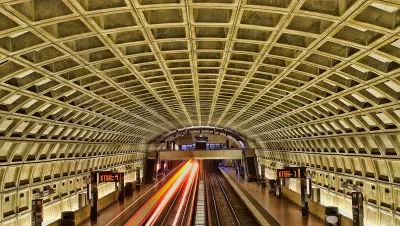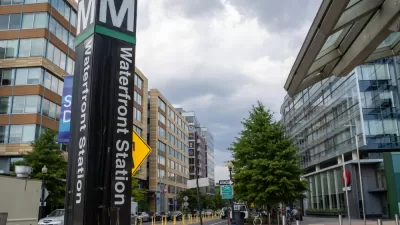While transit ridership is up around the country, the D.C. Metro has experienced the opposite. The agency's planners aren't worried about those numbers, though. They're excited about development that's bringing more residents to transit-served areas.

Factors like telecommuting and ride-sharing services seem to have taken a bite out of transit ridership in the Washington, D.C., region. And managerial troubles at Metro haven't helped. The agency's planners, though, are looking towards a bright long-term future.
They aren't so concerned about today's ridership numbers as they are about the number of people who will live and work within a half-mile of an existing transit stop. That's the commonly accepted radius of a "walk-shed"—the distance that commuters are willing to walk to get to a transit stop. Some estimates show that a full 86 percent of the office space under development in the metro area falls within a walk shed. Meanwhile, 90 percent of office leasing deals that were closed this year were for properties within a walk shed.
Much of this growth will take place in formerly moribund areas on the District's east side, with some stations expected to gain nearly 10,000 daily riders by 2020—for a total of 84,000 added trips per day and $240,000 in added revenue.
FULL STORY: Why — and at what stations — Metro expects ridership to grow

Planetizen Federal Action Tracker
A weekly monitor of how Trump’s orders and actions are impacting planners and planning in America.

Congressman Proposes Bill to Rename DC Metro “Trump Train”
The Make Autorail Great Again Act would withhold federal funding to the system until the Washington Metropolitan Area Transit Authority (WMATA), rebrands as the Washington Metropolitan Authority for Greater Access (WMAGA).

The Simple Legislative Tool Transforming Vacant Downtowns
In California, Michigan and Georgia, an easy win is bringing dollars — and delight — back to city centers.

The States Losing Rural Delivery Rooms at an Alarming Pace
In some states, as few as 9% of rural hospitals still deliver babies. As a result, rising pre-term births, no adequate pre-term care and "harrowing" close calls are a growing reality.

The Small South Asian Republic Going all in on EVs
Thanks to one simple policy change less than five years ago, 65% of new cars in this Himalayan country are now electric.

DC Backpedals on Bike Lane Protection, Swaps Barriers for Paint
Citing aesthetic concerns, the city is removing the concrete barriers and flexposts that once separated Arizona Avenue cyclists from motor vehicles.
Urban Design for Planners 1: Software Tools
This six-course series explores essential urban design concepts using open source software and equips planners with the tools they need to participate fully in the urban design process.
Planning for Universal Design
Learn the tools for implementing Universal Design in planning regulations.
Smith Gee Studio
City of Charlotte
City of Camden Redevelopment Agency
City of Astoria
Transportation Research & Education Center (TREC) at Portland State University
US High Speed Rail Association
City of Camden Redevelopment Agency
Municipality of Princeton (NJ)





























